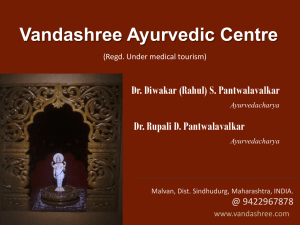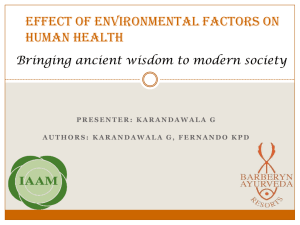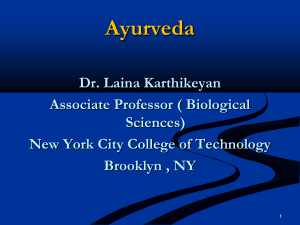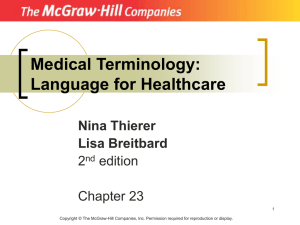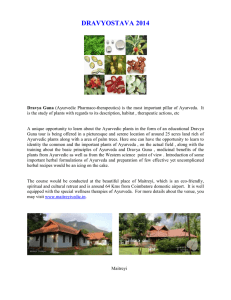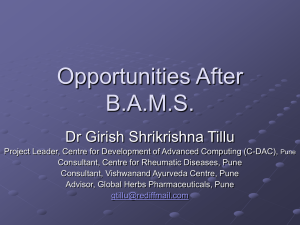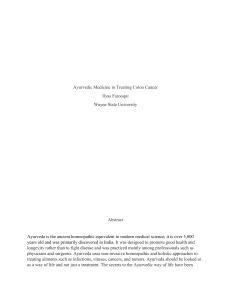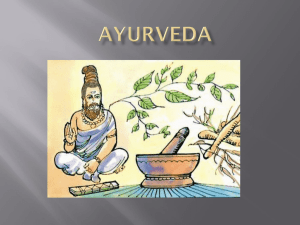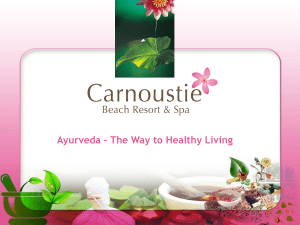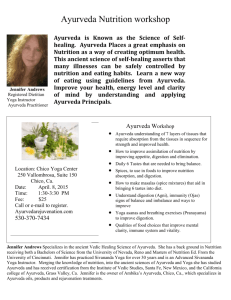Outline of Ayurveda Sessions at the
advertisement
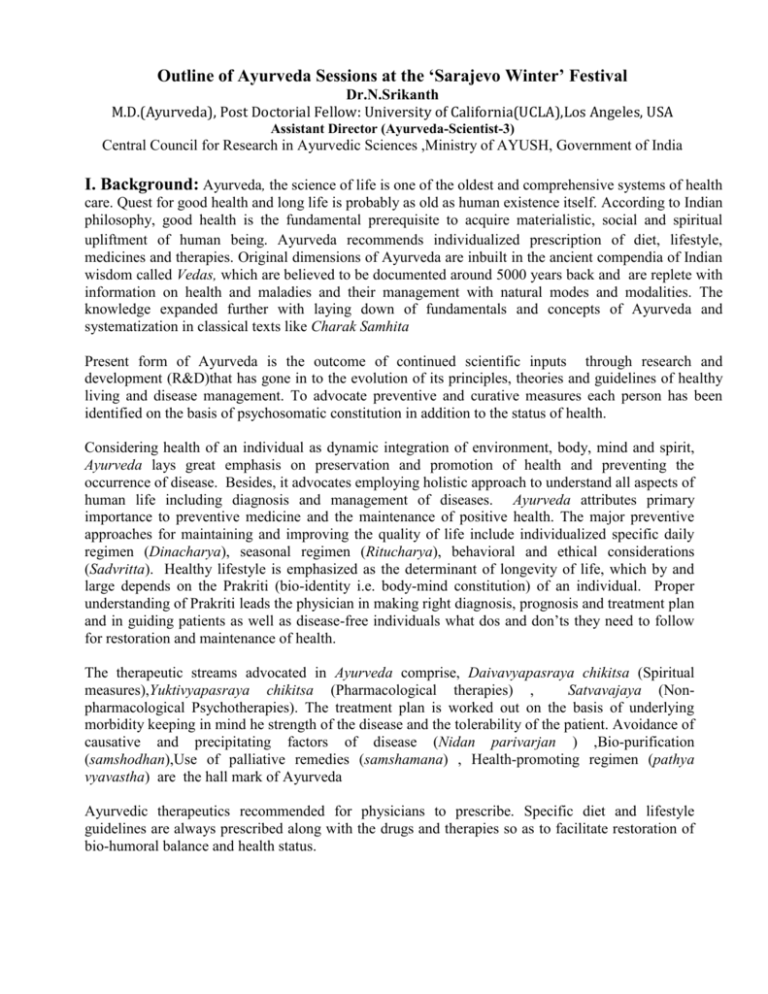
Outline of Ayurveda Sessions at the ‘Sarajevo Winter’ Festival Dr.N.Srikanth M.D.(Ayurveda), Post Doctorial Fellow: University of California(UCLA),Los Angeles, USA Assistant Director (Ayurveda-Scientist-3) Central Council for Research in Ayurvedic Sciences ,Ministry of AYUSH, Government of India I. Background: Ayurveda, the science of life is one of the oldest and comprehensive systems of health care. Quest for good health and long life is probably as old as human existence itself. According to Indian philosophy, good health is the fundamental prerequisite to acquire materialistic, social and spiritual upliftment of human being. Ayurveda recommends individualized prescription of diet, lifestyle, medicines and therapies. Original dimensions of Ayurveda are inbuilt in the ancient compendia of Indian wisdom called Vedas, which are believed to be documented around 5000 years back and are replete with information on health and maladies and their management with natural modes and modalities. The knowledge expanded further with laying down of fundamentals and concepts of Ayurveda and systematization in classical texts like Charak Samhita Present form of Ayurveda is the outcome of continued scientific inputs through research and development (R&D)that has gone in to the evolution of its principles, theories and guidelines of healthy living and disease management. To advocate preventive and curative measures each person has been identified on the basis of psychosomatic constitution in addition to the status of health. Considering health of an individual as dynamic integration of environment, body, mind and spirit, Ayurveda lays great emphasis on preservation and promotion of health and preventing the occurrence of disease. Besides, it advocates employing holistic approach to understand all aspects of human life including diagnosis and management of diseases. Ayurveda attributes primary importance to preventive medicine and the maintenance of positive health. The major preventive approaches for maintaining and improving the quality of life include individualized specific daily regimen (Dinacharya), seasonal regimen (Ritucharya), behavioral and ethical considerations (Sadvritta). Healthy lifestyle is emphasized as the determinant of longevity of life, which by and large depends on the Prakriti (bio-identity i.e. body-mind constitution) of an individual. Proper understanding of Prakriti leads the physician in making right diagnosis, prognosis and treatment plan and in guiding patients as well as disease-free individuals what dos and don’ts they need to follow for restoration and maintenance of health. The therapeutic streams advocated in Ayurveda comprise, Daivavyapasraya chikitsa (Spiritual measures),Yuktivyapasraya chikitsa (Pharmacological therapies) , Satvavajaya (Nonpharmacological Psychotherapies). The treatment plan is worked out on the basis of underlying morbidity keeping in mind he strength of the disease and the tolerability of the patient. Avoidance of causative and precipitating factors of disease (Nidan parivarjan ) ,Bio-purification (samshodhan),Use of palliative remedies (samshamana) , Health-promoting regimen (pathya vyavastha) are the hall mark of Ayurveda Ayurvedic therapeutics recommended for physicians to prescribe. Specific diet and lifestyle guidelines are always prescribed along with the drugs and therapies so as to facilitate restoration of bio-humoral balance and health status. II.. Outline and Objective of Ayurveda Sessions: The Ayurveda Sessions will focus to deliver a broad insight on Strength of Ayurveda and Evidence based Practice based on rsearch and Development. 1. Holistic Concept of Health: Ayurveda defines health as a state of equilibrium of dosha (regulatory and functional entities of the body), dhatu (structural entities), mala (excretory entities) and agni (digestive and metabolic factors) alongwith healthy state of sensory and motor organs and mind with their harmonious relationship with the soul. As against definition of health, the diseased state is defined in Ayurveda as a loss of equilibrium of essential body constituents. The objective of disease management is to bring back the equilibrium, principally through lifestyle management rather than through curative therapies. The strength of Ayurveda lies in its three fold holistic approach of prevention of disease, promotion of health and cure of disease. This is achieved through care of body, mind and soul where physical, mental and spiritual aspects of health are considered. 2 Acceptance by the community: About 80-90% of population in India is reported to use Ayurveda and other traditional systems of medicine to meet their primary health care needs. Safety of this system is attributed to time-tested use substantiated by scientific evidences. Besides, synergy of ingredients in conjunction with individual need based treatment plan forms the basis of efficacy and safety of Ayurvedic formulations. Specific guidelines are prescribed for the use of apparently toxic medicinal plants with certain detoxification processing that also enhance the bioavailability and efficacy of the final product. 3. Emphasis on promotion of Health and Prevention of Diseases: Considering health of an individual as dynamic integration of environment, body, mind and soul, Ayurveda lays great emphasis on preservation and promotion of health and preventing the occurrence of diseases. The treatment modalities of Ayurveda are based on the inherent ability of the living body to rejuvenate, regenerate and restore the natural equilibrium. While treating the patient, Ayurvedic treatment helps to enhance the natural healing process in the body. The prevention of disease and promotion of health is achieved by judicious practice of dinacharya (daily regimen), ritucharya (seasonal regimen) and sadvritta (ethical code of conduct) in accordance with prakriti (psychosomatic constitution). In this way significance of healthy life style for maintenance of health is emphasized by Ayurveda. 4. Importance of diet and lifestyle: The ultimate aim of this medical science is preservation of health and it can be attained in two ways, i.e observation of lifestyle recommendations to prevent the diseases and eradication of already afflicted diseases. The prerequisites to attain the prevention include wholesome diet, conservation of environment, congenial social and cultural atmosphere. Diet is an essential factor for the maintenance of health. Ayurveda emphasizes on diversified aspects of dietetics and nutrition viz. quality, quantity, processing methods, rationale of combination of food articles, emotional aspects, nature of the consumer, geographical and environmental conditions etc. Advocacy of proper diet and life style, which is congenial to the individual maintains normal body functions thus prevents the diseases. 5. Holistic Concept of Health: Ayurveda considers a living being as a combination of body, mind and soul. All health management approaches are intended to maintain the harmony and homeostasis of these entities. 6 Individualized Approach: Ayurveda considers that each individual has distinct psychosomatic constitution and health status. This is taken into account while advocating preventive, promotive and curative measures. 7 Universal Approach: According to Ayurveda, the individual (microcosm) is a miniature replica of the universe (macrocosm). Every aspect of the universe is represented in the individual. Any change in the environment affects human being. Therefore, emphasis is laid on social and environmental factors which are interlinked with health. 8 Stress on Public health and Eugenics: The activities of the individual through his thought, word and deed have their good or bad effects on the environment. Ayurveda emphasizes upon healthy body, sound mind, benevolent speech and spiritual practices to create a healthy and happy environment. The pivotal role of eugenics mentioned in Ayurveda is to produce strong, healthy and ideal progeny. .9 Use of natural products: Ayurvedic products are derived mainly from plants and other natural resources. Supportive leads are emerging from revalidation of Ayurvedic drugs. Identification of active principles of some plants has led to discovery of many allopathic drugs. Some pharmacologically proven constituents of the Ayurvedic plants like Aloe vera, Curcuma longa, Withania somnifera, Bacopa monnieri etc. are used globally. 10 Areas of Clinical Strength: Ayurveda provides healthcare within the physical and financial reach of rural India. Some of the Ayurvedic medicinal plants and spices are widely used as home remedies in India for a wide range of common ailments. The common users of Ayurveda are individuals suffering from chronic intractable diseases. It is an accepted fact that Ayurveda is playing an important role in conditions like bronchial asthma & bronchitis, cardiovascular disorders, osteoporosis, joint and connective tissue disorders and early stages of dementia, Parkinson’s disease, osteoarthritis etc. Ayurvedic treatment is effective in chronic disorders like sinusitis, diabetes mellitus, hypertension, obesity; psychosomatic disorders like depression, insomnia; digestive disorders like irritable bowel syndrome (IBS), peptic ulcer, inflammatory bowel diseases; respiratory disorders like bronchial asthma and chronic obstructive pulmonary disease; musculo-skeletal disorders like arthritis, osteoporosis; neurological and neuro-degenerative disorders like paralytic condition etc. 11 Unique therapeutic approach: Ayurveda advocates certain bio-cleansing and rejuvenating therapeutic measures such as panchakarma, rasayana for maintenance of healthy state as well as in the management of chronic diseases. Ksharasutra, a minimal invasive para-surgical procedure using medicated thread, widely cited in ancient medical literatures for its safety and efficacy is being successfully practiced as promising therapy for ano-rectal disorders. Such unique specialties of Ayurveda either as stand alone or add on therapies are proven to have an edge over conventional medical approach in disease management and improving quality of life. The credible therapeutic modalities comprise bio-purification therapy Panchakarma ,Minimal invasive para surgical measure for management of fistula-in-ano Ksharsutra ,Specialized health promotive & rejuvenate approach for geriatric health care - Rasayana. These modalities are proven to have an edge over conventional medical approach in dealing with chronic and refractory disease conditions. 12 Research &Development and Evidence Based Practice; During the last decade, use of Ayurveda and other traditional medicine has expanded globally and has gained popularity. They have not only continued to be used for primary health care of the poor in developing countries, but has also been used in countries where conventional medicine is predominant in the national health care system. With the tremendous expansion in the use of Ayurveda worldwide, safety and efficacy as well as quality control of herbal medicines and traditional procedure-based therapies have become important concerns for both health authorities and the public and much attention has been made to address the same through Research &Development and Regulation. The way forward: Ayurveda can contribute in the management of chronic and refractory disease conditions sharing huge global burden such as cancer, rheumatoid arthritis and allied conditions. III. Structure of the Sessions: The sessions comprise Power Point Presentations followed by interactions and discussions (each of 1hour duration) Presentations Ayurveda based and preventive, health promotive and therapeutic approaches Life style Advocacy in Ayurveda Nutritional issues in Ayurveda Evidence Based Ayurveda- Profile &focus on Research and Development(R&D) with insight on insight on Non communicable diseases Any other Aspects of Ayurveda
